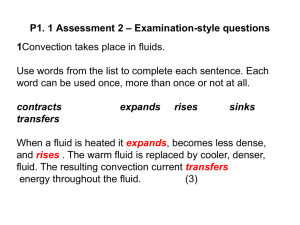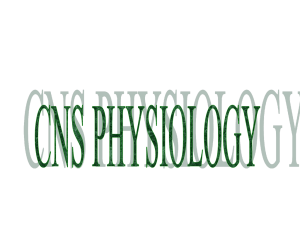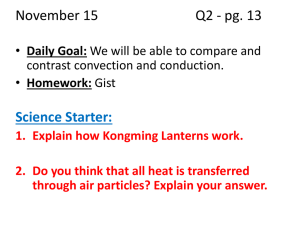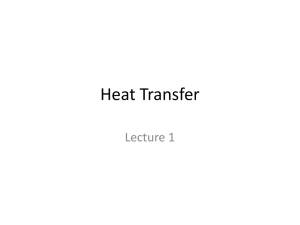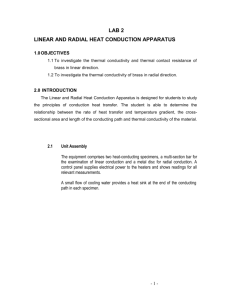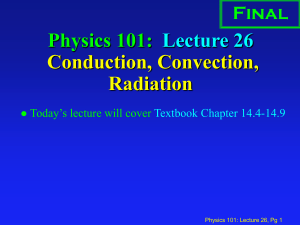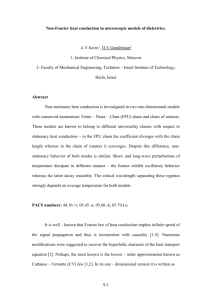3) Extended Surface Heat Transfer 12
advertisement
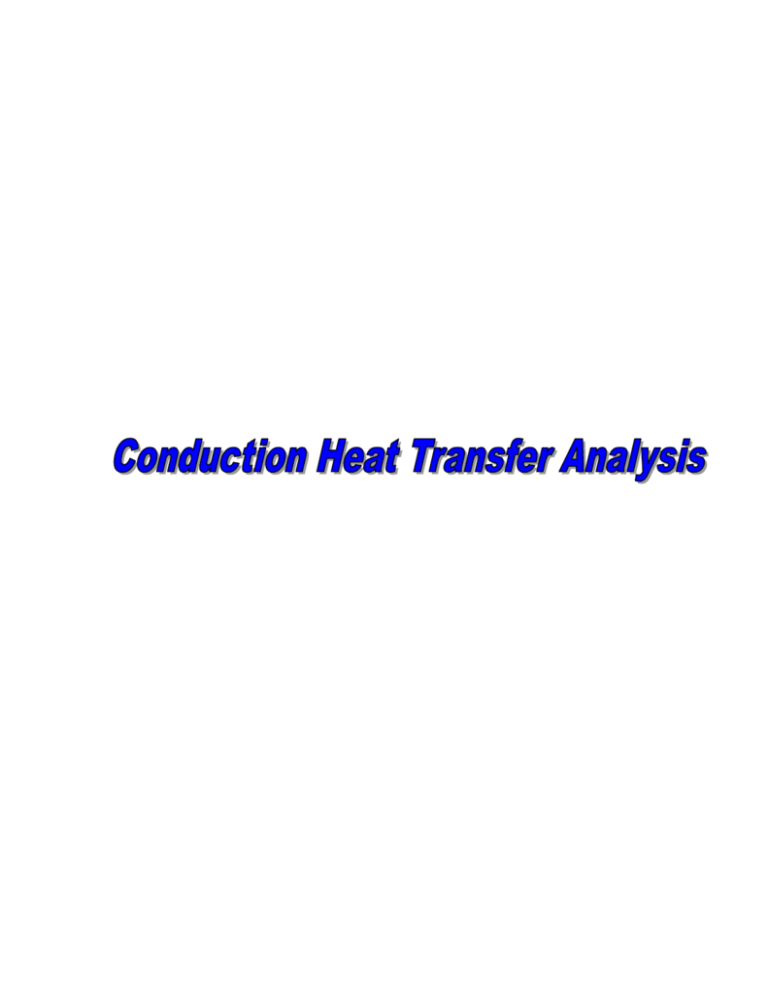
Table of Contents Principle 3 Objective 3 Background 3 ▪ Fourier’s law of Heat Conduction 3 ▪ The Pin Fin 6 ▪ Governing Equation and Boundary Conditions 6 ▪ Temperature Distribution 8 Apparatus 9 1) Linear heat conduction equipment: 10 Description of the Linear Heat Conduction Equipment 10 2) Radial heat conduction equipment: 11 Description of the Radial Heat Conduction Equipment 12 Useful information: 12 3) Extended Surface Heat Transfer 12 Description of the Extended Surface Heat Transfer Equipment 12 Useful information: 13 Procedure 13 References 13 Experiment1 2 INME 4032 University of Puerto Rico Mayagüez Campus Department of Mechanical Engineering INME 4032 - LABORATORY II Spring 2004 Instructor: Guillermo Araya Experiment 1: Conduction Heat Transfer Analysis Principle A heat source placed in a material causes temperature changes due to heat conduction. The relationship between temperature and the distance from the heat source must be linear after some time in the case of linear heat conduction and it must have a logarithmic distribution in the case of radial heat conduction. Objective The experiment demonstrates heat conduction in three different experimental models. It allows us to obtain experimentally the coefficient of thermal conductivity of some unknown materials and in this way, to understand the factors and parameters that affect the rates of heat transfer. Background Fourier’s law of Heat Conduction A general statement of the Fourier’s law is: The conduction heat flux in a specified direction equals the negative of the product of the medium thermal conductivity and the temperature derivative in that direction. In Cartesian coordinates, with temperature varying in the x direction only, q k dT dx In cylindrical or spherical coordinates, with temperature varying in the r direction only, q k Experiment1 3 dT dr INME 4032 Fig 1.1. A cylindrical shell showing an elemental control volume for application of the energy conservation principle. Figure 1.1 shows a cylindrical shell of length L, with inner radius r1 and outer radius r2. The inner surface is maintained at temperature T1 and the outer surface is maintained at temperature T2. An elemental control volume is located between radii r and r+Δr. If temperatures are unchanging in time and Q v 0 , the energy conservation principle requires that the heat flow across the face at r equal that at the face r+Δr Q r Q r r That is, Q r Constant, independent of r Using Fourier’s law dT Q r Aq 2rL k dr Dividing by 2kL and assuming that the conductivity k is independent of temperature gives Q dT r Constant C1 2kL dr Experiment1 4 INME 4032 which is a first-order ordinary differential equation for T(r) and can be integrated easily: C dT 1 dr r T C1 ln r C2 Two boundary conditions are required to evaluate the two constants; these are r r1 : T T1 r r2 : T T2 Substituting; T1 C1 ln r1 C2 T2 C1 ln r2 C2 which are two algebraic equations for the unknowns C1 and C2. Subtracting the second equation from the first: T1 T2 C1 ln r1 C1 ln r2 C1 ln( r2 / r1 ) or C1 T1 T2 ln( r2 / r1 ) Using either of the two equations then gives C 2 T1 T1 T2 ln r1 ln( r2 / r1 ) Substituting back and rearranging gives the temperature distribution as T1 T ln( r / r1 ) T1 T2 ln( r2 / r1 ) which is a logarithmic variation, in contrast to the linear variation found for the plane wall. The heat flow is Q 2kLC1 or: Experiment1 5 INME 4032 Q 2kL(T1 T2 ) ln( r 2 / r1 ) The Pin Fin Simple pin fins, such as those used to cool electronic components, will be analyzed to develop the essential concepts of fin theory. The first law is used to derivate the governing differential equation, which, when solved subject to appropriate boundary conditions, gives the temperature distribution along the fin. Governing Equation and Boundary Conditions Fig. 1.2 A pin fin showing the coordinate system and an energy balance on a fin element. Consider the pin fin shown in Fig. 1.2. The cross sectional area is Ac=R2 where R is the radius of the pin, and the perimeter P =2R. Both Ac and R are uniform, that is, they do not vary along the fin in the x direction. The energy conservation principle is applied to an element of the fin located between x and x + Δx. Heat can enter and leave the element by conduction along the fin and can also be lost by convection from the surface of the element to the ambient fluid at temperature Te. The surface area of the element is Experiment1 6 INME 4032 P Δx; thus. qAc x qAc xx hc P x( T Te ) Dividing by Δx and letting Δx 0 gives d ( qAc ) hc P ( T Te ) 0 dx For the pin fin, Ac is independent of x; using Fourier’s law q = –k dT/dx with k constant gives d 2T kAc 2 hc P ( T Te ) 0 dx which is a second order ordinary differential equation for T=T(x). Notice that modeling the conduction along the fin as one-dimensional has caused the convective heat loss from the sides of the fin itself, it is appropriate to take its base temperature as known; that is, T x 0 TB At the other end, the fin losses heat by Newton’s law of cooling: Ac k dT dx Ac hc (T xL xL Te ) where the convective heat transfer coefficient here is, in general, different from the one for the sides of the fin because the geometry is different. However, because the area of the end, Ac, is small compared to the side area PL, the heat loss from the end is correspondingly small and usually can be ignored. Then Equation becomes dT dx Experiment1 0 x L 7 INME 4032 Temperature Distribution We will use the last equation for the second boundary condition as a compromise between accuracy and simplicity of the result. For mathematical convenience, let θ = T – Te and β2=hcP/ kAc; so d 2 2 0 2 dx For β a constant, Equation has the solution C1e x C 2 e x or B1 sinh x B2 cosh x The second form proves more convenient; thus, we have T Te B1 sinh x B2 cosh x Using the two boundary conditions, we have two algebraic equations for the unknown constants B1 and B2, TB Te B1 sinh( 0) B2 cosh( 0) ; B2 TB Te dT dx B1 cosh L B2 sinh L 0 ; xL B1 B2 tanh L Substituting B1 and B2 and rearranging gives the temperature distribution as T Te cosh (L x ) , TB Te cosh L Experiment1 8 1/ 2 where h P c kA c INME 4032 Apparatus There are three different experimental models to study the heat transfer by conduction: 1. 2. 3. Linear Heat Conduction Radial Heat Conduction Extended surface heat transfer 1. Linear Heat Conduction Equipment: Heat transfer module Linear Heat Conduction Equipment Fig. 1.3 Schematic Diagram showing the Heat Conduction Equipment Description of the Linear Heat Conduction Equipment: The heat transfer module is cylindrical and mounted with its axis vertical to the base plate. The heating section houses a 25mm diameter cylindrical brass section with a nominally 60W (at 24 VDC) cartridge heater in the top end. The three fixed thermocouples T1, T2, T3, positioned along the heated section, are at 15mm intervals. The cooling section is also manufactured from 25mm diameter brass to match the heated top section and this is cooled at its bottom end by water flowing through galleries in the material. Three fixed thermocouples T6, T7, T8 are positioned along the cooled section at 15mm intervals. There are four different specimens available to be placed between the heated and the cooled sections. These specimens are the following: Experiment1 9 INME 4032 Brass Specimen: 30mm long, 25mm diameter fitted with two thermocouples T4, T5 at 15mm intervals along the axis. With this specimen clamped between the heated and cooled sections, a uniform 25mm diameter brass bar is formed with 8 uniformly spaced (15mm intervals) thermocouples (T1 to T8). Stainless Steel specimen 30mm long, 25mm diameter. No thermocouples fitted. Aluminum Alloy specimen 30mm long, 25mm diameter. No thermocouples fitted. Brass specimen With Reduced Diameter 30mm long, 13mm diameter. No thermocouples fitted. NOTE: If the experimental session requires the use of two specimens, use first the specimen with the heater at no more than 10V, then use the second specimen with the heater at different volts according the instructions of your instructor. If more than 10V are used for the first specimen, the second one will not fit in the shallow shoulders of the heated and cooled sections because of the thermal expansion. 2. Radial Heat Conduction Equipment: Radial Heat Conduction Equipment Fig. 1.4 Schematic Diagram showing the Radial Conduction Equipment Experiment1 10 INME 4032 Description of the Radial Heat Conduction Equipment: The radial heat conduction equipment allows investigate the basic laws of heat conduction through a cylindrical solid. The heat transfer module comprises an insulated solid disc of brass (110mm diameter) with a solid copper core (14mm diameter), and an electric heater at the center. The brass disc is water cooled around its circumference. Six fixed thermocouples T1, T2,…, T6 are located at increasing radio from the heated center. Useful information: Heated disc Material: brass Outside diameter: 0.110m Diameter of heated copper core: 0.014m Thickness of disc: 0.0032m Radial position of thermocouples: T1 = 0.007m T4 = 0.030m T2 = 0.010m T5 = 0.040m T3 = 0.020m T6 = 0.050m 3. Extended Surface Heat Transfer Description of the Extend Surface Heat Transfer Equipment: The extended surface heat transfer equipment allows investigation of one-dimensional conduction from a fin. A small diameter metal rod is heated at one end and the remaining exposed length is allowed to cool by natural convection and radiation. The equipment comprises a 10mm diameter brass rod of approximately 350mm effective length mounted horizontally. Eight thermocouples are located at 50mm intervals along the rod to record the surface temperature. The rod is coated with a matt black paint in order to provide a constant radiant emissivity close to 1. Experiment1 11 INME 4032 T8 Extended Surface Heat Transfer Equipment T7 T6 T5 T4 T3 T2 T1 Fig. 1.3 Schematic Diagram showing the Extended Surface Heat Transfer Equipment Useful information Heated Rod Diameter D = 0.01m Heated Rod Effective Length L = 0.35m Thermal Conductivity of the Heated Rod Material k = 121 W/mK Procedure Allow the system to reach stability, and take readings and make adjustments as instructed in the individual procedures for each experiment. Record the temperatures, voltage and current, with these data; calculate the power of the heat source. Repeat the lectures three times to assure that the system has reached stability. You should investigate about how to use your information in order to calculate the thermal conductivity coefficient in all the cases and you must graph your data to study the behavior of temperature against distance from the heat source. All this experimental strategy must be presented in the Task Discussion Meeting. References P. A. Hilton LTD. “Experimental Operating and Maintenance Manual”. Heat Transfer Service Unit. November, 2000. A. Mills, “Basic Heat and Mass Transfer”, Richard D. Irwin INC, Los Angeles, USA, 1995. Experiment1 12 INME 4032
